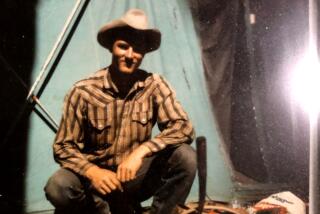I’d wake up and watch the sunlight play on the mesa and the butte, and it would turn gold.
- Share via
Evelyn Tiger retired as a registered nurse in 1969 and went into the Peace Corps in Kenya for two years. She continued working as a volunteer in her community, but this summer she decided on a change of scenery. The experience gave her something she had been missing in her work at home. Tiger lives in Thousand Oaks.
I saw a little article about the National Park Service taking senior volunteers. I filled out the application and kept wondering, “What in the world am I getting into?” I got a letter from the Student Conservation Assn. saying I’d been accepted and would I go to Chaco Culture National Historic Park, in New Mexico. I got out the map and I found it up in the Four Corners area.
I drove into Chaco Canyon over the worst dirt, washboardy road I have ever been on. I practically crawled along. You shook, rattled and rolled when you came down that road. Finally I got inside the park boundary.
At first, the most difficult thing was learning how to get up in the morning and working nine hours a day, five days a week. I’d been retired for many years, and I’d been getting up at 9 o’clock in the morning and leisurely having my breakfast. Here I was, getting up at 7 o’clock in the morning.
After the first week I didn’t resent that because it was so beautiful. I’d wake up and watch the sunlight play on the mesa and the butte, and it would turn gold. I would eat my breakfast and watch the gold turn to tan.
I was the only volunteer. I was called a resource assistant. There was a permanent staff of four rangers, three seasonal rangers, an archeologist and a young man who was doing photography of the ruins.
In the mornings I would go to all the trail guide boxes, collect the money and restock the boxes. Then I would check the gate counter at the north gate and the south gate to see how many cars had come in. That was about 20 miles that I would drive in the morning.
Then I would go back to the visitors’ center and work, giving out information, selling the books, postcards and things like that. I learned how to run a cash register through lots of mistakes. I was always screaming, “Please come help me, what did I do now?”
In the afternoon I would either study or go out on ruin walks through the various pueblos, answering questions. I started reading from the day I arrived, and I didn’t finish reading until the day I left. They had an excellent library with all of the information that the archeologists had written, plus many other writers too.
I was walking four or five miles a day. I lost six pounds in the three months I was there. The first day I started going at my usual pace, and I found I was out of breath, so I slowed up. You don’t realize the difference between 700 feet elevation and 6,000 feet.
Every day I would walk somewhere I hadn’t been before. I would see new petroglyphs, pictures that are pecked right into the cliff walls. I also saw pictographs, pictures that were painted on the wall. These were done a thousand years ago and they’re still there for us to look at. Every day was an adventure.
There were people there from all over the world. We met British people, Germans, French and Italians. There were artists and photographers. We had the Harmonic Convergence there in August. When school began, we had busloads of children in from Gallup, Acoma and Albuquerque.
I’ve lived here for 14 years, and I’ve discovered you’re out of the mainstream here in Thousand Oaks. You mingle with a small group of people who think the way you do. Suddenly I found what I’d been missing all these years, being with a lot of divergent people, all these people with whom I talked at Chaco. It was such a revelation. In nursing, every day you are exposed to different people. I realized how important that it is to me. That’s why I would like to keep on doing this.
I’ll write the Student Conservation Assn. next week and tell them I’m ready for an assignment in the winter or next summer. I’m saving April, May and June for Chaco. I’d like to see it in the spring.
More to Read
Sign up for The Wild
We’ll help you find the best places to hike, bike and run, as well as the perfect silent spots for meditation and yoga.
You may occasionally receive promotional content from the Los Angeles Times.





